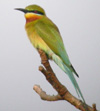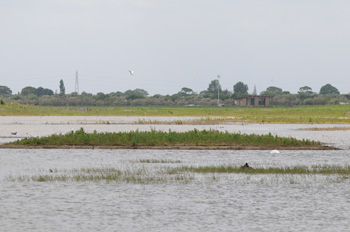 INTRODUCTION
INTRODUCTION
Having already been to Norfolk and Suffolk for 5 nights in mid April, we decided to go back to Norfolk for a shorter spell to try and catch up with the later migrants we had previously missed.
DIARY and SITE INFORMATION
Day 1 - Monday 31st May
As we were staying near King’s Lynn we decided to call at RSPB Frampton Marsh on our way down. We had been to the reserve 3 weeks earlier for the Oriental Pratincole (a lifer for us both) and had enjoyed our visit so much we felt the site was well worth a second look. We were not disappointed with a small flock of lingering Dark-bellied Brent Goose, an eclipse drake Garganey, 2 Wood Sandpiper, 4 Little Gull, Yellow Wagtail, Yellowhammer and Corn Bunting being the highlights amongst 6 species of duck and 10 species of wader. After checking in to our hotel late in the afternoon we headed out to Holme NWT to try and catch up with Barn Owl, which had eluded us on our previous trip. Once again we failed, as we did for the next few days: we have now spent the best part of 10 days in Norfolk and Suffolk this year and still not seen a Barn Owl! Totally unheard of in previous years. A short walk in the dunes yielded a pair of Grey Partridge and Linnet, whilst Marsh Harrier floated across the adjacent fields. 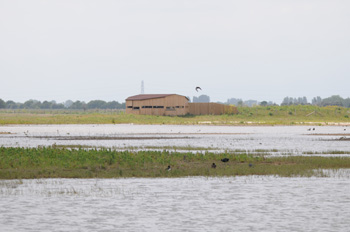 After a bite to eat at The Lifeboat Inn at Thornham we moved on to Sandringham to look for Nightjar. In the past we have always been successful by taking the minor road opposite the first turning to the Wolferton Triangle (travelling north on the A149 from King’s Lynn to Hunstanton) and stopping at the first parking area on the right, about 100 metres from the main road. Walking down the broad track into the conifer plantations, we heard roding Woodcock and briefly saw a bird overhead as we moved c300 metres from the road. At around 21.40hrs in the gathering gloom, we heard a Nightjar “churring” and quickly located the male, perched at the top of a nearby conifer. Despite the failing light we had excellent views of the bird as it hunted overhead and returned to several favoured perches in the treetops: an excellent end to our first day, as we had enjoyed beautiful sunshine at Frampton and only encountered cloud in Norfolk in the early evening.
After a bite to eat at The Lifeboat Inn at Thornham we moved on to Sandringham to look for Nightjar. In the past we have always been successful by taking the minor road opposite the first turning to the Wolferton Triangle (travelling north on the A149 from King’s Lynn to Hunstanton) and stopping at the first parking area on the right, about 100 metres from the main road. Walking down the broad track into the conifer plantations, we heard roding Woodcock and briefly saw a bird overhead as we moved c300 metres from the road. At around 21.40hrs in the gathering gloom, we heard a Nightjar “churring” and quickly located the male, perched at the top of a nearby conifer. Despite the failing light we had excellent views of the bird as it hunted overhead and returned to several favoured perches in the treetops: an excellent end to our first day, as we had enjoyed beautiful sunshine at Frampton and only encountered cloud in Norfolk in the early evening.
Day 2 - Tuesday 1st June
After a leisurely breakfast we set out for the raptor watch-point at Great Ryburgh, arriving at 10.00hrs by which time the birds are usually becoming active. With rain threatening and a gloomy day forecast, we had allocated an hour to scan the skies here, before moving on further inland and south to Lakenheath. We met a local volunteer, who had dropped by to check out a reported sighting the previous evening and he advised us that our target, Honey Buzzard, had not yet returned to the area as far as he was aware. Single Marsh Harrier and Kestrel were the only raptors we saw, along with a supporting cast of farmland species, geese and Little Egret. By 11.15hrs with nothing really happening, apart from the rain settling in, we decided to head for the coast rather than inland, as that was the direction the weather was approaching from. 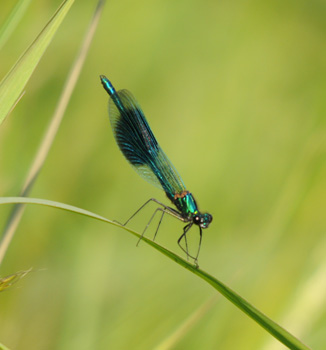 The previous day a Trumpeter Finch had turned up at NWT Cley and as we hadn’t seen one in the UK previously, we decided to set off in that direction; as it turns out, quite a fortuitous choice really. Having just managed to park the car at the nearby NOA Walsey Hills reserve, we set off along the East Bank to the shingle ridge at the shoreline in very light rain which, thankfully, stopped ten minutes later. The bird had proved a little flighty and with quite a few eager birders in pursuit, had moved a long way east from its original favoured spot towards Salthouse and had disappeared about 10 minutes before we got there. Along with a few other new arrivals, we continued east along the shingle ridge and after about 20 minutes managed to re-locate the adult male Trumpeter Finch, which was well camouflaged against the shingle background. With a photographer not content with excellent scoped views and crawling up the bank just behind the bird like the SAS on manoeuvres, we decided to leave the finch in peace after watching it for 10 minutes. The behaviour of some of the” long lens brigade” really does leave a lot to be desired, as they strive for that frame-filling shot of a lifetime, totally regardless of other birders and the welfare of the bird itself. Both Sedge and Reed Warbler were very vocal all along the East Bank. Next we moved along to the West Bank, where a stunning, summer male Red-backed Shrike was giving excellent views to the assembled crowd. After a refreshing pit stop at the Cley café, we drove a little further along the coast to NWT Salthouse, where a singing male Marsh Warbler had been leading birders a merry dance all day as it flitted amongst the shrubs and bushes on the landward side of the shingle ridge. Hearing the bird was easy! Getting a good view required patience, but after about 40 minutes we had seen the bird several times (and enough to confirm its identity) as it moved up and down and in and out of the vegetation whilst feeding furiously. With the weather continuing to brighten up we set off back towards our hotel, calling at Abbey Farm Flitcham on the way, prior to dining at The Crown Inn at East Rudham. Most of the usual birds you would expect to find at this excellent little site were around, with the notable exception of Kingfisher and Little Owl. Both birds nest around the farm but we have missed them on two visits this year and indeed, have still not seen Little Owl at all on our travels in 2010…. our local pair seem to have disappeared after the hard winter. Particularly pleasing, but distant, was a lone Turtle Dove, perched on a fence post for 15 minutes. Before retiring for the evening we stopped once again at Sandringham, as we passed, to try and get a better sighting of Woodcock. Within 5 minutes of getting out of the car I had a good view of a bird roding overhead, as it flew across the clearing. After a slow start, another good day, with some very pleasant surprises along the way.
The previous day a Trumpeter Finch had turned up at NWT Cley and as we hadn’t seen one in the UK previously, we decided to set off in that direction; as it turns out, quite a fortuitous choice really. Having just managed to park the car at the nearby NOA Walsey Hills reserve, we set off along the East Bank to the shingle ridge at the shoreline in very light rain which, thankfully, stopped ten minutes later. The bird had proved a little flighty and with quite a few eager birders in pursuit, had moved a long way east from its original favoured spot towards Salthouse and had disappeared about 10 minutes before we got there. Along with a few other new arrivals, we continued east along the shingle ridge and after about 20 minutes managed to re-locate the adult male Trumpeter Finch, which was well camouflaged against the shingle background. With a photographer not content with excellent scoped views and crawling up the bank just behind the bird like the SAS on manoeuvres, we decided to leave the finch in peace after watching it for 10 minutes. The behaviour of some of the” long lens brigade” really does leave a lot to be desired, as they strive for that frame-filling shot of a lifetime, totally regardless of other birders and the welfare of the bird itself. Both Sedge and Reed Warbler were very vocal all along the East Bank. Next we moved along to the West Bank, where a stunning, summer male Red-backed Shrike was giving excellent views to the assembled crowd. After a refreshing pit stop at the Cley café, we drove a little further along the coast to NWT Salthouse, where a singing male Marsh Warbler had been leading birders a merry dance all day as it flitted amongst the shrubs and bushes on the landward side of the shingle ridge. Hearing the bird was easy! Getting a good view required patience, but after about 40 minutes we had seen the bird several times (and enough to confirm its identity) as it moved up and down and in and out of the vegetation whilst feeding furiously. With the weather continuing to brighten up we set off back towards our hotel, calling at Abbey Farm Flitcham on the way, prior to dining at The Crown Inn at East Rudham. Most of the usual birds you would expect to find at this excellent little site were around, with the notable exception of Kingfisher and Little Owl. Both birds nest around the farm but we have missed them on two visits this year and indeed, have still not seen Little Owl at all on our travels in 2010…. our local pair seem to have disappeared after the hard winter. Particularly pleasing, but distant, was a lone Turtle Dove, perched on a fence post for 15 minutes. Before retiring for the evening we stopped once again at Sandringham, as we passed, to try and get a better sighting of Woodcock. Within 5 minutes of getting out of the car I had a good view of a bird roding overhead, as it flew across the clearing. After a slow start, another good day, with some very pleasant surprises along the way.
Day 3 - Wednesday 2nd June
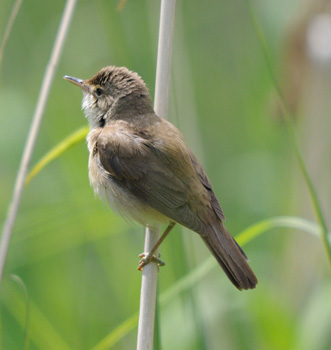 Today the weather had changed completely; the wind had dropped and the sun shone from an almost cloudless sky and we set off at 08.00hrs for RSPB Lakenheath in the hope of catching up with Golden Oriole amongst others. Arriving shortly after the reserve had opened, we set off on the 3 mile trek to the Joist Fen viewpoint with high hopes, as birds had already been reported singing in the top two woods. We soon heard our first male singing as we walked towards the second strand of Black Poplars and this was to set the tone for the morning – we listened to Golden Oriole song for up to two hours and although Amanda caught a brief glimpse of the male, it flew off before she could get me on to the location. In the meantime we had excellent views of 3 or 4 Hobby hunting over the fens, very brief sightings of Bittern and Cetti’s Warbler as they appeared momentarily above the reeds and several pairs of Marsh Harrier floated around the reserve. Unfortunately, the Cranes didn’t perform at Joist Fen, despite watching for over an hour, but we did see a lone Kingfisher as it flashed across the water in front of us and several Cuckoo busily laying their eggs in the nests of their unsuspecting hosts. Despite the presence of up to 50 Hobby on passage during May, there were still substantial numbers of dragonflies around the reserve, including Black-tailed Skimmer and Four Spotted Chaser. In the early afternoon we moved on to NWT Weeting Heath hoping to see Woodlark; only to be told by the warden that the birds had fledged a week ago and had not been seen from the hides since then. Undaunted we spent an hour searching in vain (a certain theme for the day is emerging here) but were rewarded with good views of Marsh Tit, a dishevelled Mistle Thrush, a pair of Stock Dove and a distant Stone Curlew. We then decided to return to Lakenheath for one last try with the Golden Orioles: although it was late afternoon, the heat of the day remained and the whole reserve was much quieter than in the morning. We managed to see a couple of Spotted Flycatcher and a singing Reed Warbler, but nothing else of note. As we returned towards the visitor centre at around 17.30hrs we finally heard another Oriole calling from within the Poplars. I spent 20 minutes listening to the bird as it moved around the trees, but finally gave up as a group of 5 noisy birders came along, ostensible to look out for Orioles, but more realistically to talk rather loudly about other birds they had seen abroad (and anything else that took their fancy) whilst the calls slowly vanished into the distance. Quite a frustrating day really, but that’s birding for you!
Today the weather had changed completely; the wind had dropped and the sun shone from an almost cloudless sky and we set off at 08.00hrs for RSPB Lakenheath in the hope of catching up with Golden Oriole amongst others. Arriving shortly after the reserve had opened, we set off on the 3 mile trek to the Joist Fen viewpoint with high hopes, as birds had already been reported singing in the top two woods. We soon heard our first male singing as we walked towards the second strand of Black Poplars and this was to set the tone for the morning – we listened to Golden Oriole song for up to two hours and although Amanda caught a brief glimpse of the male, it flew off before she could get me on to the location. In the meantime we had excellent views of 3 or 4 Hobby hunting over the fens, very brief sightings of Bittern and Cetti’s Warbler as they appeared momentarily above the reeds and several pairs of Marsh Harrier floated around the reserve. Unfortunately, the Cranes didn’t perform at Joist Fen, despite watching for over an hour, but we did see a lone Kingfisher as it flashed across the water in front of us and several Cuckoo busily laying their eggs in the nests of their unsuspecting hosts. Despite the presence of up to 50 Hobby on passage during May, there were still substantial numbers of dragonflies around the reserve, including Black-tailed Skimmer and Four Spotted Chaser. In the early afternoon we moved on to NWT Weeting Heath hoping to see Woodlark; only to be told by the warden that the birds had fledged a week ago and had not been seen from the hides since then. Undaunted we spent an hour searching in vain (a certain theme for the day is emerging here) but were rewarded with good views of Marsh Tit, a dishevelled Mistle Thrush, a pair of Stock Dove and a distant Stone Curlew. We then decided to return to Lakenheath for one last try with the Golden Orioles: although it was late afternoon, the heat of the day remained and the whole reserve was much quieter than in the morning. We managed to see a couple of Spotted Flycatcher and a singing Reed Warbler, but nothing else of note. As we returned towards the visitor centre at around 17.30hrs we finally heard another Oriole calling from within the Poplars. I spent 20 minutes listening to the bird as it moved around the trees, but finally gave up as a group of 5 noisy birders came along, ostensible to look out for Orioles, but more realistically to talk rather loudly about other birds they had seen abroad (and anything else that took their fancy) whilst the calls slowly vanished into the distance. Quite a frustrating day really, but that’s birding for you!
Day 4 - Thursday 3rd June
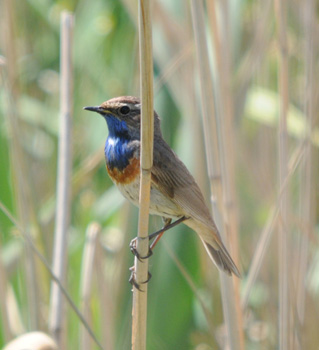 We were returning home today, but first of all decided to make a detour via WWT Welney to try for the male Bluethroat which had been singing there since April. Arriving shortly after the reserve had opened, once again in glorious sunshine, we were greeted by a departing birder with the news that the bird was “showing well” in the usual place. Full of eager anticipation we made tracks for the Lyle Hide where the bird appeared to have taken up residence and were advised that it had gone to ground about 10 minutes earlier, having been chased off by the local, territorial Whitethroat. For the next two hours we waited patiently, stood on an uncomfortable bank, but with no further luck. Both Sedge and Reed Warbler were busy feeding young nearby and the Whitethroat put in the occasional appearance, singing briefly from the top of a small bush. Just after noon we decided to have a spot of lunch in the reserve café and picked up Little-ringed Plover, Ringed Plover, Avocet and Yellow Wagtail from the main hide along the way. Not to be defeated, we decided on one more hour back near the Lyle Hide before setting off for home and after about 40 minutes there was a flurry of excitement as a superb male White-spotted Bluethroat suddenly put in an appearance and sang and displayed for about 15 minutes before going quiet again. In pristine summer plumage, the bird was well worth the long wait and a super finale to our short trip to Norfolk.
We were returning home today, but first of all decided to make a detour via WWT Welney to try for the male Bluethroat which had been singing there since April. Arriving shortly after the reserve had opened, once again in glorious sunshine, we were greeted by a departing birder with the news that the bird was “showing well” in the usual place. Full of eager anticipation we made tracks for the Lyle Hide where the bird appeared to have taken up residence and were advised that it had gone to ground about 10 minutes earlier, having been chased off by the local, territorial Whitethroat. For the next two hours we waited patiently, stood on an uncomfortable bank, but with no further luck. Both Sedge and Reed Warbler were busy feeding young nearby and the Whitethroat put in the occasional appearance, singing briefly from the top of a small bush. Just after noon we decided to have a spot of lunch in the reserve café and picked up Little-ringed Plover, Ringed Plover, Avocet and Yellow Wagtail from the main hide along the way. Not to be defeated, we decided on one more hour back near the Lyle Hide before setting off for home and after about 40 minutes there was a flurry of excitement as a superb male White-spotted Bluethroat suddenly put in an appearance and sang and displayed for about 15 minutes before going quiet again. In pristine summer plumage, the bird was well worth the long wait and a super finale to our short trip to Norfolk.
SUMMARY
Although we had missed out on Honey Buzzard, Golden Oriole, Common Crane and Woodlark and failed miserably to connect with Barn Owl and Little Owl, we saw several other totally unexpected species in our overall total of 96, plus four others which were only heard. As we drove home, just after joining the A1 south of Peterborough, I was amazed to hear a burst of Nightingale song from the roadside, near the first coffee and petrol stop around Chesterton. Unfortunately we were past the turn off by the time it registered, or else we would have made another coffee stop and had a little wander around.
Species List
David and Amanda Mason
